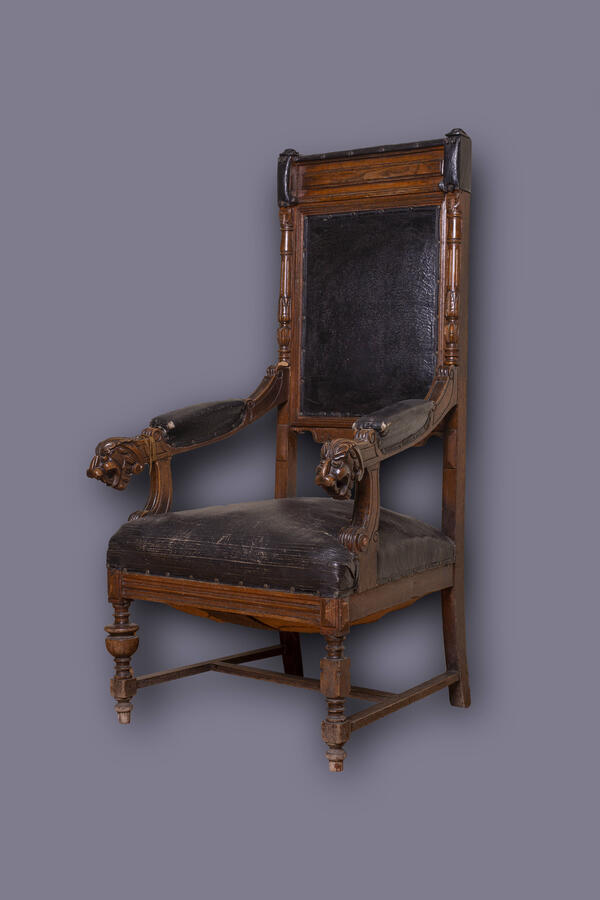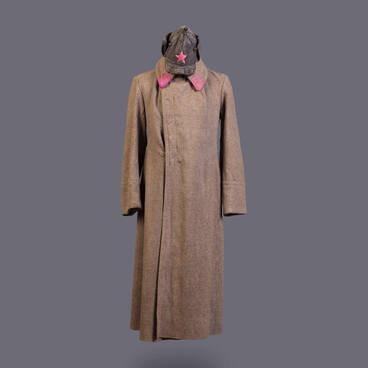The Renaissance style armchair stood in the office of the manager of the City Public Bank of Stary Oskol. The development of local industry and trade led to the establishment of banks in the city. The first bank, called the City Public Bank, was opened in Stary Oskol in 1868. At that time its capital amounted to 10 000 rubles.
The first director of the bank was Vasily Mikhailovich Chernikov. Ivan Petrovich Makarov, a merchant from Stary Oskol, was elected the bank’s deputy director. Later, he became the director of the bank, and at the same time an honorary caretaker of the city college. In addition to financial operations the bank was actively engaged in charity. During 25 years of existence, about 8000 rubles were allocated from the bank profits for the construction of municipal buildings and maintenance of educational institutions. By the decision of the city council, the bank director I. P. Makarov was awarded the title of Honorary citizen of Stary Oskol for his outstanding social activities. The merchant Makarov became the first honorary citizen of the city.
In 1900, a branch of the Russo-Asian Bank, one of the five largest banks of Russia in the late 19th century, was opened in Stary Oskol. In 1896, a special building was constructed for it. The bank had a turnover of up to 95 million rubles in 1913. At the beginning of the 20th century there was also a branch of the Northern Commercial Bank, operating in the city. Stary Oskol ranked first among the county cities of the Kursk governorate in terms of the number of banks and the amount of banking capital.
The history of Stary Oskol reflects all the peculiarities of life in small county cities of the Russian province. At the end of the 18th century, by 1779, Stary Oskol became a county city in the Kursk province, which was renamed governorate in 1792. By that time, the city had finally ceased to serve as a military fortress and had become a regular city and the administrative center of an agricultural county.
The basis of the economy of the region in the 19th century was agriculture, industry was underdeveloped. The first enterprises that appeared in the city, were associated with the processing of agricultural products. At the end of the 19th century in Stary Oskol there were 17 factories and plants. Stary Oskol was also the center of the grain trade in the east of Kursk governorate. The main trade turnover was provided by the fairs. There were 17 of them in the county.
The first director of the bank was Vasily Mikhailovich Chernikov. Ivan Petrovich Makarov, a merchant from Stary Oskol, was elected the bank’s deputy director. Later, he became the director of the bank, and at the same time an honorary caretaker of the city college. In addition to financial operations the bank was actively engaged in charity. During 25 years of existence, about 8000 rubles were allocated from the bank profits for the construction of municipal buildings and maintenance of educational institutions. By the decision of the city council, the bank director I. P. Makarov was awarded the title of Honorary citizen of Stary Oskol for his outstanding social activities. The merchant Makarov became the first honorary citizen of the city.
In 1900, a branch of the Russo-Asian Bank, one of the five largest banks of Russia in the late 19th century, was opened in Stary Oskol. In 1896, a special building was constructed for it. The bank had a turnover of up to 95 million rubles in 1913. At the beginning of the 20th century there was also a branch of the Northern Commercial Bank, operating in the city. Stary Oskol ranked first among the county cities of the Kursk governorate in terms of the number of banks and the amount of banking capital.
The history of Stary Oskol reflects all the peculiarities of life in small county cities of the Russian province. At the end of the 18th century, by 1779, Stary Oskol became a county city in the Kursk province, which was renamed governorate in 1792. By that time, the city had finally ceased to serve as a military fortress and had become a regular city and the administrative center of an agricultural county.
The basis of the economy of the region in the 19th century was agriculture, industry was underdeveloped. The first enterprises that appeared in the city, were associated with the processing of agricultural products. At the end of the 19th century in Stary Oskol there were 17 factories and plants. Stary Oskol was also the center of the grain trade in the east of Kursk governorate. The main trade turnover was provided by the fairs. There were 17 of them in the county.



